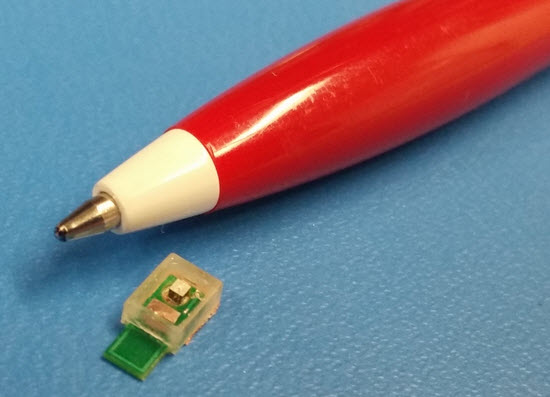A tiny ultrasound-powered chip to serve as medical device
October 20, 2014

Stanford engineers can already power this prototype medical implant chip without wires by using ultrasound. Now they want to make it much smaller. (Credit: Arbabian Lab / Stanford School of Engineering)
Stanford engineers are developing a way to send power — safely and wirelessly — to “smart chips” in the body that are programmed to perform medical tasks and report back the results.
The idea is to get rid of wires and batteries, which would make the implant too big or clumsy.
Their approach involves beaming ultrasound at a tiny device inside the body designed to do three things: convert the incoming sound waves into electricity; process and execute medical commands; and report the completed activity via a tiny built-in radio antenna.
“We think this will enable researchers to develop a new generation of tiny implants designed for a wide array of medical applications,” said Amin Arbabian, an assistant professor of electrical engineering at Stanford.
Arbabian’s team recently presented a working prototype of this wireless medical implant system at the IEEE Custom Integrated Circuits Conference in San Jose.
Sound-powered implants
The researchers chose ultrasound to deliver wireless power to their medical implants because it has been safely used in many applications, such as fetal imaging, and can provide precision and sufficient power to implants a millimeter or less in size.
Arbabian and his colleagues are collaborating with other researchers to develop sound-powered implants for a variety of medical applications, from studying the nervous system to treating the symptoms of Parkinson’s disease.
The Stanford medical implant chip is powered by piezoelectricity (pressure on a material generates an electric voltage). The Stanford team created pressure by aiming ultrasound waves at a tiny piece of piezoelectric material mounted on the device.
In the future, the team plans to extend the capabilities of the implant chip to perform medical tasks, such as powering sensors or delivering therapeutic jolts of electricity right where a patient feels pain.
The “smart chip” also contains a RF antenna to beam back sensor readings or signal the completion of its therapeutic task.
The current prototype is the size of the head of a ballpoint pen. They plan to design a next-generation implant one-tenth that size to interface with brain cells, using arrays of micro implants across the entire 3D structure of the brain, and for other uses.
Abstract of A mm-Sized Implantable Device with Ultrasonic Energy Transfer and RF Data Uplink for High-Power Applications
A first proof-of-concept mm-sized implant based on ultrasonic power transfer and RF uplink data transmission is presented. The prototype consists of a 1 mm x 1 mm piezoelectric receiver, a 1 mm x 2 mm chip designed in 65 nm CMOS and a 2.5 mm x 2.5 mm off-chip antenna, and operates through 3 cm of chicken meat which emulates human tissue. The implant supports a DC load power of 100 µW allowing for high-power applications. It also transmits consecutive UWB pulse sequences activated by the ultrasonic downlink data path, demonstrating sufficient power for an Mary PPM transmitter in uplink.